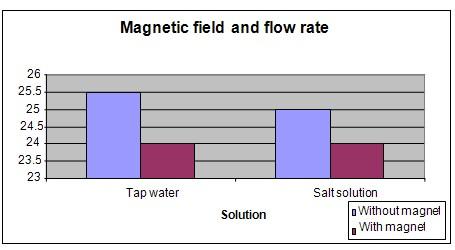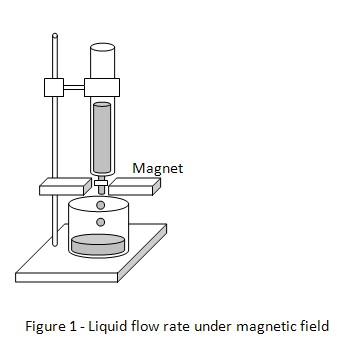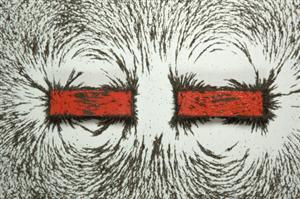| Complexity level: | 7 |
| Project cost ($): | 20 |
| Time required: | 1 hour for preparation and 1 hour for science fair project |
| Material availability: | Laboratory access required |
| Safety concerns: | Basic safety requirements |
Hypothesis
Under the influence of an adequately strong magnetic field, the salt solution will have a slower rate of flow than the tap water
Overview
Diamagnetism
Diamagnetism is the behavior of certain materials that forms an opposing magnetic field when it is exposed to an external magnetic field generated by a permanent magnet. Diamagnetic materials normally have a relative permeability of less than 1, causing them to be repelled by the magnetic field.
The magnetic field from an external permanent magnet will have its flux lines curved away from the diamagnetic materials, resulting in repulsion. The magnetic field will also be slightly weakened by the diamagnetic material.
Water is diamagnetic. It is able to slightly attenuate and repel the magnetic field from an external permanent magnet. This weakening effect is greater when salt water is used. In theory, if water is able to repel a magnetic field, it should then be possible to slow down the rate of flow of water through a narrow channel, by introducing a sufficient strong magnetic field along the channel.
Scientific Terms
Materials
The materials required for this cool science fair project are:
- 400 ml of tap water
- 50 grams of salt
- 2 beakers
- 1 burette
- 1 measurement cylinder
- 1 stop watch
- 2 large permanent magnets
Procedure
1. The independent variables of this science fair project is the type of water used (salt solution and tap water) and whether the a magnetic field is or is not present. The dependent variable is the time taken for the fluid to flow out of the burette. This is measured using a stopwatch. The constants control variables are the amount of water used, the strength of the permanent magnet used, the flow rate of the burette and the room temperature.

2. The experiment layout is as shown in figure 1 above.
3. Fill 200ml of tap water into the measuring cylinder. This is thenpoured into the burette. The flow rate of the burette is set and the same conditions will be used for the subsequent experiments.
4. The time taken for the 200 ml of tap water to flow out of the burette (without any magnetic field applied) is measured. Repeat this process up to 5 times and the average time taken will be calculated and recorded in the table provided below. .
5. Step 4 is repeated by placing 2 permanent magnets at the bottom of the burette as shown in figure 1. This measurement is again, repeated 5 times for us to obtain the average timing required, which will be recorded in the table provided below.
6. Mix 50 grams of salt with 200 ml of tap water in a separate beaker. Using the measuring cylinder, pour 200 ml of salt solution into the burette. Repeat steps 4 and 5 using the salt solution. The average timing taken for 5 tests are calculated and recorded in the table provided below.


Results
The results show that the flow rates of both the salt solution and tap water are being reducedwhen a magnetic field is being applied at the bottom of the burette. The flow rate of the salt solution is lower than that of the tap water under the influence of a magnetic field.
| Condition | Time taken for 200ml to flow out of burette (seconds) | |
| Tap water | Salt solution | |
| Without magnets | 25.5 | 25 |
| With magnets | 24 | 24 |
Plot the results of your observation into a graph, as shown below.

Conclusion
The hypothesis that salt solution has a lower flow rate than tap waterunder the influence of a magnetic field is proven to be true.
One of the demonstrations and possible applications of diamagnetism is in levitation. Diamagnetic materials can be levitated in a strong magnetic field when a state of equilibrium is achieved. The levitation of diamagnetic materials has been demonstrated in laboratories using pyrolytic graphite, water and even a livee frog.
Also consider
This science fair project can also be executed using different types of fluids like distilled water, sugar solution, alcohol or vinegar.
Also consider repeating this experiment at different temperatures.
This experiment can be performed using multiple or permanent magnets of varying strengths.
What if the rate of flow of the solution were to be increased or decreased significantly? What do you think would happen?
References
Diamagnetism - http://en.wikipedia.org/wiki/Diamagnetism
Magnetism through salt water - http://en.allexperts.com/q/Science-Kids-3250/2009/1/magnetism-salt-water-1.htm

